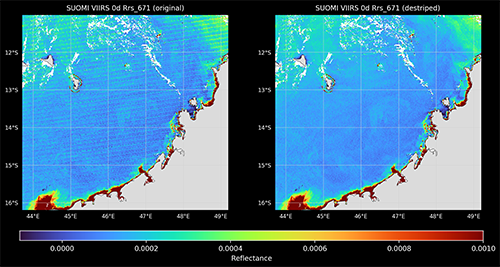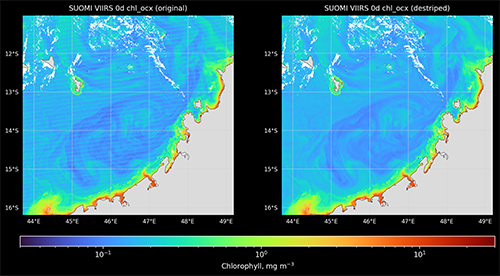Destriping is now routinely applied to NOAA-20 and SUOMI Visible Infrared Imaging Radiometer Suite (VIIRS) data processed by NEODAAS to remove stripe artefacts and improve the quality of data supplied to users.
The VIIRS instrument acquires visible and infrared imagery over the land and oceans. It is the successor of MODIS and has been in continuous operation since the first VIIRS sensor was launched in October 2012 on the NOAA Suomi National Polar-orbiting Partnership spacecraft (SNPP). This was followed by a second VIIRS instrument, launched on board the NOAA-20 satellite in November 2017.
There are a wide range of applications for the data collected by VIIRS including investigating snow and ice cover, fires, sea surface temperature, vegetation health, phytoplankton abundance and chlorophyll concentration.
VIIRS is a whiskbroom radiometer which scans the Earth’s surface using a rotating mirror that reflects radiation onto 16 individual detectors. This multidetector arrangement has a number of benefits, including enhanced spatial resolution, however slight calibration or performance differences between the detectors, or artefacts from the rotating mirror, can introduce false ‘stripe’ artefacts in VIIRS images.
Where these artefacts are caused by the sensor, removing them prior to further processing is beneficial because they can impact data quality and downstream applications, such as detecting ocean fronts.

 Image: Examples of SUOMI VIIRS images before and after the destriping. The top images show remote sensing reflectance at 671nm and the bottom images show chlorophyll concentration (using the OC3 algorithm) derived from the destriped reflectance bands. Images are from 01/08/2020 of the north-western coast of Madagascar and Mozambique Channel.
Image: Examples of SUOMI VIIRS images before and after the destriping. The top images show remote sensing reflectance at 671nm and the bottom images show chlorophyll concentration (using the OC3 algorithm) derived from the destriped reflectance bands. Images are from 01/08/2020 of the north-western coast of Madagascar and Mozambique Channel.
NEODAAS have implemented a destriping program which was created by the
NOAA Ocean Color group and provided to NEODAAS, with some adaptions, by Consiglio Nazionale Delle Ricerche (CNR), Istituto di Scienze Marine, Italy. This program is based on the destriping algorithm by
Mikelsons et al., 2014.
The algorithm splits an image into a striped and stripe-free component using a gradient threshold, then over several iterations filters the striped component and adds this back to the stripe-free component to produce the final image. The benefit of this method is that real features in an image (e.g. fronts or eddies) are preserved in the stripe-free image and are not blurred by filtering.
Emma Sullivan, Earth Observation Scientist at Plymouth Marine Laboratory (PML), commented:
“VIIRS is a very useful sensor for our work, however the striping artefacts can negatively impact image quality and the subsequent analysis. Adding the destriping stage to the NEODAAS processing chain has provided a substantial improvement in the data quality we can provide. As well as benefiting NEODAAS users, it will also be used in other projects at PML such as those detecting harmful algal blooms and the Ocean Colour Climate Change Initiative project”.
This algorithm is now being applied routinely to NEODAAS near-real time (NRT) and refined operational processing chains and the resulting images are being provided for current cruise support. These datasets are available to view on the
NEODAAS portal.